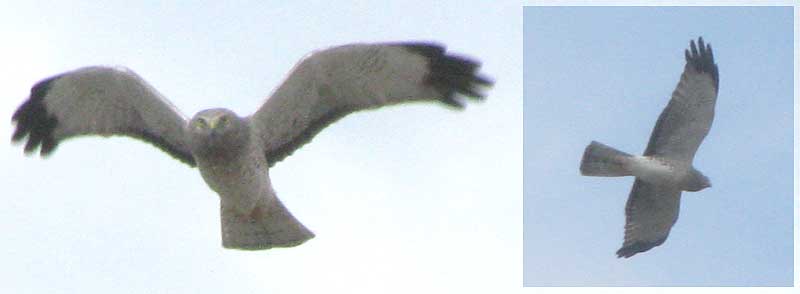Excerpts from Jim Conrad's
Naturalist Newsletter

from the March 24, 2013 Newsletter issued from the valley of the Dry Frio River in northern Uvalde County, southwestern Texas, on the southern border of the Edwards Plateau; elevation ~1750m (~5750 ft); N29.62°, W99.86°; USA
NORTHERN HARRIER
All winter a certain long-tailed, low-flying hawk has patrolled the Dry Frio Valley's grassy fields occasionally swooping and pouncing on rodents espied hurrying down raceways between clumps of grass. I've tried many times to photograph the bird but he flies so low that he's upon you before you know it and by the time the camera is ready he's gone, or else nearby and moving so fast you can't focus on him. This week, however, I just happened to see him coming, so I got what's shown above.
The shot on the left shows the bird's owl-like face with eyes set forward in a way that provides binocular vision, thus enhancing depth perception. Good depth perception is needed for catching rodents scrambling through grass. That picture also shows an unusual feature of how this species flies: its wings held well above the horizontal. The image at the right shows the bird's exceptionally long tail. However, neither picture shows what may be the most vivid field mark of all, which is the white "rump" -- the rump being the lower back just above where tail feathers attach.
I grew up calling this the Marsh Hawk because that's how early bird field guides in the US identified them, but over the years most guides seem to have gravitated to the name Northern Harrier. "Harrier" and "Hen Harrier" are names used in Europe, where the species also occurs. In fact, our Northern Harrier enjoys an usually large distribution area, occurring all across North America and Eurasia. During the winter Eurasian birds migrate into southern Europe and southern temperate Asia while American breeders overwinter in the southern US, through Mexico and Central America, into northern South America.
Northern Harriers, CIRCUS CYANEUS, are unusual hawks. In field guides typically they're listed separately from slender-bodied, long-tailed, rounded-winged "accipiters" such as the Cooper's and Sharp-shinned Hawk, as well as apart from the "buteos" with their broad, rounded tails and thick bodies, such as the Red-tailed and Broad-winged hawks. When you see how consistently low-flying the bird is, and how owlishly he looks at you as he glides past, it's easy to believe he's something special, something different from the usual hawks we see. One other feature unusual for a hawk is that among Northern Harriers males and females are colored differently: Males are predominantly gray while females are brown. Our bird is clearly a male.
I'm glad I finally got this picture, for soon Northern Harriers will disappear from our grasslands and won't return until fall, after nesting is finished far to the north.